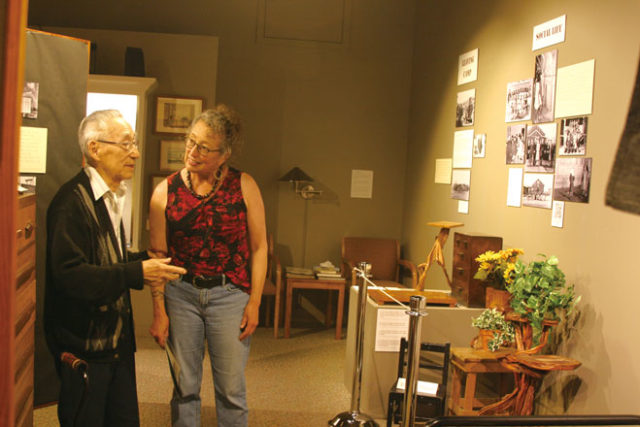
Shihou Sasaki
The North American Post
Handmade items displayed at a local museum are educational, inspirational and testimonial and share what the Japanese Americans faced over 70 years ago.
The White River Valley Museum in Auburn has been running a special exhibit, “Handmade in Camp: What We Couldn’t Carry,” from this summer through Nov. 6 to feature the Japanese American incarceration through handmade crafts and items.
The items, numbering over 60, come from collections from the museum, other local institutions and individual contributors. They include such objects from household items to jewelry, family tools, arts works, quilts, scrapbooks and even furniture. “Each item, whether a chest of drawers made from scrapped fruit crates or a piece of jewelry made from shells, is a testament to human ingenuity, craft and courage,” the press release states.
The items on display started from the Pearl Harbor attack, Executive Order 9066 and mass-removal telling the internees that they were allowed to bring only a few items that fit in a couple suitcases. But these items were quickly created due to demand for objects used in their daily lives, including such things as a Buddhist home altar crafted by Jack Yoshio Natsuhara in August 1942 at Tule Lake incarceration camp.
“We gain a unique and highly personalized vantage point to history by seeing items made out of necessity, simple things made by hand because people needed them and simply had to make do,” states Patricia Cosgrove, director of the museum.
The exhibit is also divided by themes including religion, school, social life, military service and camp departure.
Several interview quotes collected by the museum are found in the exhibit to share the situation of camp life or the crafting processes. Some other interviews are also available through the mobile storytelling app STQRY.
According to the museum, the valley area had 300 Japanese families before World War II, about one-third of the population in Auburn, but only about 25 families returned. Cosgrove added that many visitors find familiar names and people in the exhibit but do not know the history and what happened to them.
“I think this [exhibit] is a soft way to look at the subjects and introduce the history,” she said.
Cosgrove recalled that this would be the fourth exhibit specializing in Japanese American history at the museum besides previous features of Military Intelligence Service, Nikkei Art Heritage and White River Japanese community.
The museum also has a permanent exhibit of Japanese immigrants to the valley. A part of the exhibit shares the items that could not be brought to the incarceration camps but were left and cared for by the locals.
One summer weekday, Cosgrove gave a short tour for long-time friend Hiro Nishimura. The 96-year-old Nisei (second generation Japanese American) said that the exhibit is very important as a process for him to learn about the incarceration camps that he did not experience due to his service in Military Intelligence Service.
Nishimura said that he has joined the Minidoka Pilgrimage four times to visit where his family was sent. He added that being with family members was at least good, but that “Nobody knows how long they would stay, what would happen to them.”
Cosgrove said that it is always amazing to learn how Japanese Americans went through such severe and unjust experiences and how they could be great models of American society.
Nishimura could not find an exact answer for Cosgrove, but shortly said about the exhibit, “Japanese people don’t waste time. Time is important.”
The museum will present a few related events, including a film screening of “The Manzanar Fishing Club” with curator Ken Matsudaira at 1 p.m. on Sept. 17 and a Japanese kite workshop with Greg Kono at 1 p.m. on Oct. 21.
More information can be found at www.wrvmuseum.org.







